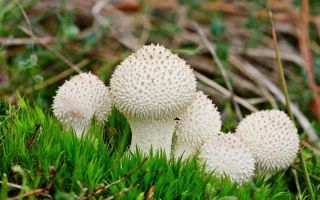Content
The medicinal properties of the raincoat mushroom are often used by traditional medicine. To use the dust collector with benefit, it is necessary to study its features and effects on the body.
What does an edible mushroom raincoat look like and where does it grow?
Mushroom raincoat, dust, or "grandfather's tobacco" (Lycoperdon), belongs to the Champignon family and consists of a fruiting body, usually not having a clear division into a leg and a cap. It has an ovoid, pear-shaped or round shape.
The surface of the fungus is smooth or covered with small thorns and warts, whitish, grayish or yellowish in color. At a break, the pulp is dense at a young age, but as it ripens, it dries up and turns into a spore powder. The latter comes out of the hole in the upper part of the mushroom and is carried around with the wind. An adult raincoat is covered with an inner leathery and smooth outer shell.
There are several varieties of edible dust collectors:
- Pear-shaped (Lycoperdon pyriforme). As the name implies, it resembles a pear in shape. Covered with a whitish shell with cracks and scales on the surface.
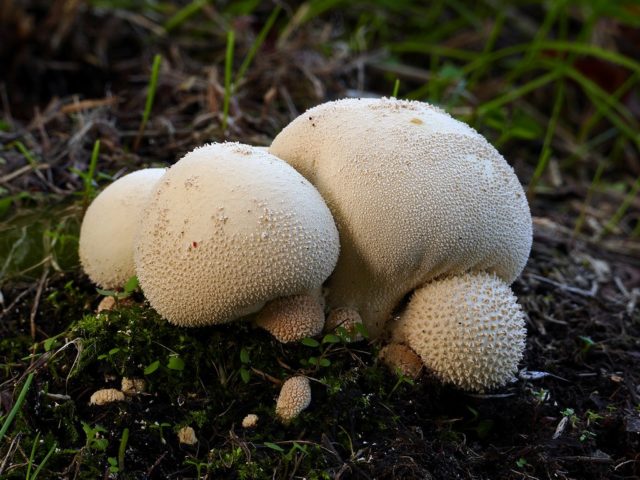 The size of a pear-shaped raincoat does not exceed 5-6 cm
The size of a pear-shaped raincoat does not exceed 5-6 cm - Lugovoi (Lycoperdon pratense). The shape of a white or brownish mushroom in adulthood is spherical, slightly flattened. In size, the species can reach 6 cm in width. Has a well-defined wrinkled leg up to 1.2 cm in height.
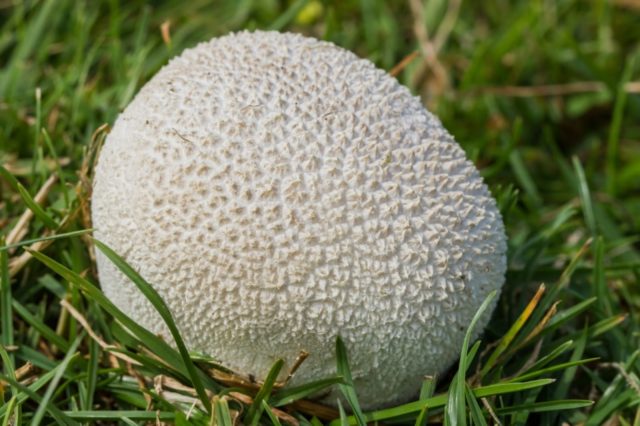 The pulp of a meadow raincoat has a strong pleasant smell
The pulp of a meadow raincoat has a strong pleasant smell - Prickly (Lycoperdon perlatum). The shape of the fungus is hemispherical, with a well-distinguishable false stem and a tubercle in the upper part of the fruiting body. Small thorns are visible on the surface.
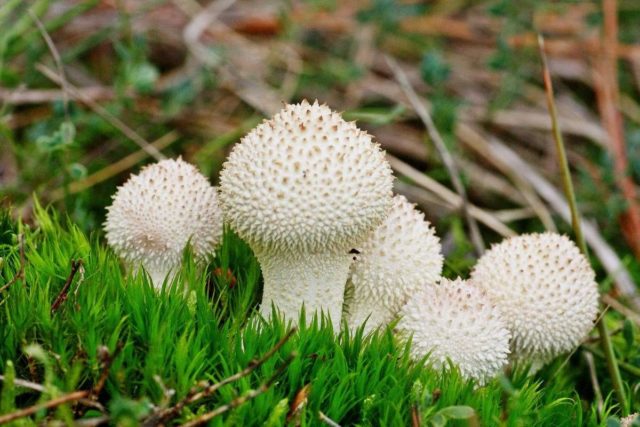 At a young age, the spiky slicker is white, but turns brown as it grows
At a young age, the spiky slicker is white, but turns brown as it grows
The raincoat mushroom is widespread all over the world - it is impossible to find it only in Antarctica. Prefers grassy meadows and glades, coniferous and deciduous forests. Often the raincoat mushroom grows on trees, mostly felled, and on stumps. Fruiting from June to late autumn.
Raincoat composition
The raincoat mushroom is prized in folk medicine due to its rich chemical composition. The fruiting bodies contain:
- iron, sodium and potassium;
- amino acids;
- iodine;
- fats;
- ergosterol;
- lipids;
- enzymes;
- calvacic acid;
- mineral salts;
- leucine and tyrosine;
- polysaccharides;
- antibiotic compounds;
- chitin.
The special value of a raincoat lies in the presence of a large amount of proteins in its composition. The mushroom is recommended to be consumed with a lack of meat in the diet.
Why are mushrooms raincoats useful?
In terms of taste, the raincoat is inferior to more valuable mushrooms. However, its pulp has numerous medicinal properties. With proper use, the mushroom improves the condition of the body, namely:
- helps to remove slags, toxins and heavy metal salts from tissues;
- fights bacterial processes and pathogenic microorganisms;
- inhibits the growth of oncological tumors and serves as the prevention of cancer;
- improves the functioning of the stomach and intestines;
- strengthens blood vessels and prevents atherosclerosis;
- has a beneficial effect on the condition of the liver;
- increases the body's immune capabilities;
- improves the condition of the kidneys and genitourinary system;
- stops bleeding.
Medicines based on a raincoat can be used externally for skin ailments. Preparations from the pulp of the mushroom have a beneficial effect on joint diseases.
How to make raincoat mushroom tincture
Traditional medicine uses mainly alcohol tincture of a raincoat for medicinal purposes. It has good stimulating, warming and strengthening properties. They make it according to this recipe:
- the collected mushrooms are washed and dried from moisture, and then cut into arbitrary pieces or left intact;
- the raw material is placed in a glass vessel so as to fill it halfway;
- the remaining volume is poured with high-quality vodka to the very neck;
- removed in a dark place for infusion, closed for 40 days.
After the expiration date, the product is filtered and poured into another container. It is necessary to take the tincture for diseases of the liver, stomach and kidneys once a day, 5 ml.

The use of raincoat mushroom in folk medicine
The beneficial properties of the raincoat mushroom are used for many ailments. Traditional medicine suggests using natural raw materials in the form of a strong tincture or dry powder.
With a runny nose
In case of a cold, raincoat powder has a good effect. The tool is done like this:
- collected young mushrooms are washed from contamination;
- dried in the sun until moisture completely evaporates from the pulp;
- grind by hand or with a blender.
For nasal congestion, it is necessary to suck in mushroom powder in each nostril 2-3 times in a row. The agent will not harm the body, but will have a local irritant effect on the mucous membranes. This will help clear your sinuses and allow breathing to return.
For skin ailments
For skin irritations and dermatitis, you can use a raincoat mushroom tincture. Do it as follows:
- a glass jar is filled with raincoats by 1/2 of the total volume;
- good vodka is diluted with clean water in equal proportions and the liquid is poured into the vessel up to the neck;
- cork the container and put it in a cool, dark place for two weeks.
After the time has elapsed, the tincture is filtered and ten drops of lavender essential oil are added to it. The tool is used to wipe irritated skin and for lotions.
For liver diseases
In case of liver and kidney diseases, tincture on matured dry raincoats helps well. They do it according to the following algorithm:
- a glass clean jar is half filled with mushrooms;
- from above, the raw material is poured with vodka to the neck;
- if necessary, lightly tamp the mushrooms and add liquid;
- cleaned in a dark place for 40 days, not forgetting to shake up the product daily.
The finished tincture must be filtered from the sediment through cheesecloth folded in several layers. The drug is taken in a small spoonful in the evening.
With multiple sclerosis
Mushroom tincture has a good effect on blood vessels and activates brain activity. In the complex treatment of multiple sclerosis, you can use the following remedy:
- dry raincoats, porcini mushrooms and mushrooms are mixed in 10 g each;
- put raw materials in a glass jar and pour 750 ml of Cahors wine;
- put away in a dark place for insisting for a week;
- filter after expiration.
It is necessary to use a medicinal product in a large spoon up to four times a day.
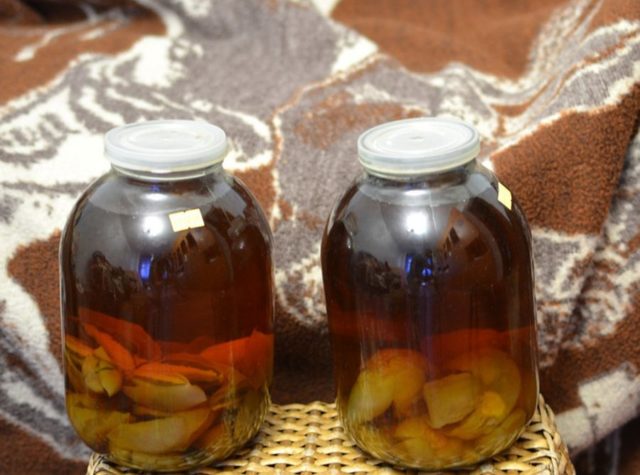
With oncology
Tincture of raincoat mushroom can be used in the treatment of cancer. Traditional medicine offers the following recipe:
- dry raincoats are ground to obtain a glass of spore powder;
- pour raw materials 500 ml of high-quality vodka;
- the vessel is tightly closed with a lid and removed for 24 days in a dark, cool place - in a cellar, basement, or even buried underground.
The finished product must be filtered through a layer of gauze, without shaking. Pure tincture is consumed on an empty stomach three times a day, 15 ml.
With acne
The antiseptic properties of the raincoat are beneficial for acne, pimples and acne breakouts. To cleanse the skin, prepare the following lotion:
- fresh dust collectors, cut into plates, are poured into a washed 1 liter jar, filling the vessel halfway;
- pour the remaining space with vodka, previously diluted with water in a 1: 1 ratio;
- clog the vessel and put it in a dark place for two weeks;
- filter and add 5 ml of tea tree oil to the tincture.
You need to use the lotion twice a day - in the morning and in the evening. A small amount of the product is applied to a cotton pad and wiped over the face.
Contraindications and possible harm
The benefits and harms of a raincoat are combined with each other. In some cases, it is forbidden to eat the mushroom and use medicines based on it. It is necessary to refuse to use a dust collector:
- during pregnancy and during breastfeeding;
- with individual allergies;
- with severe liver disease;
- with renal failure.
It is necessary to use the pulp of a dust collector with caution with sluggish digestion and a tendency to constipation, the composition contains chitin, which is not absorbed by the intestines.
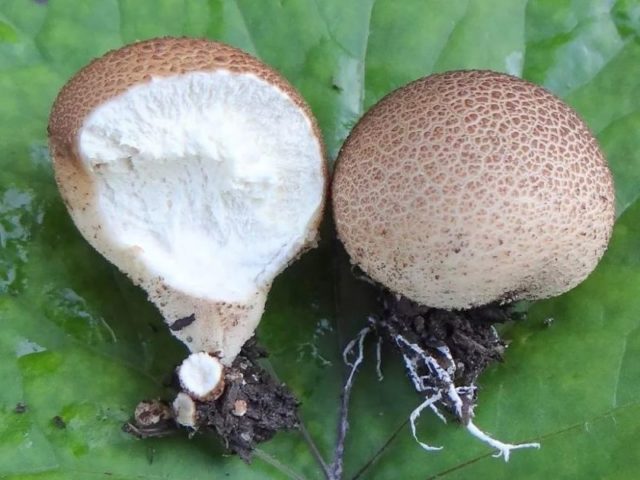
When collecting medicinal raw materials, it is important not to confuse a raincoat with inedible false mushrooms. They can usually be distinguished by their gray or brown color and a very flattened shape. Before collecting dust collectors, you need to carefully study their photos and put in the basket only those fruit bodies, the species of which is not in doubt.
A raincoat can be harmful if it was grown in an environmentally unfriendly area. For food and medicinal use, mushrooms must be collected away from roads, factories and factories. Fruit bodies absorb all toxic substances from the soil and can be very dangerous.
Conclusion
The medicinal properties of the raincoat mushroom can be used for serious chronic ailments and skin inflammations. Only fresh pulp of young fruit bodies is suitable for eating, but medicinal tinctures are made, including from old ripe dust collectors.

